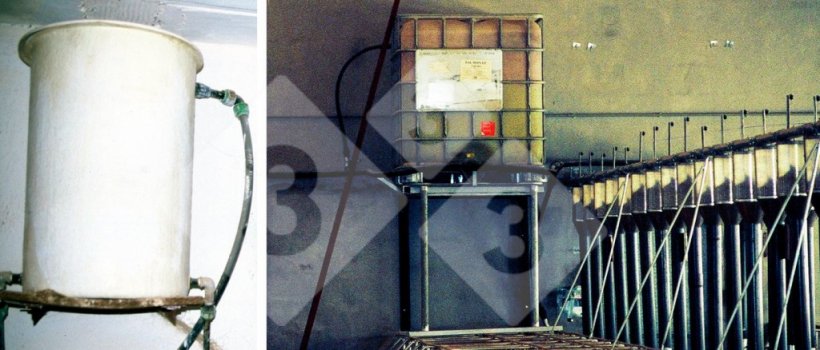Medicating water using a tank is an easy and flexible method used to administer drugs, but it can be imprecise if the products we use aren’t totally soluble. As with any other system there are a several critical points we should keep in mind if we want to successfully medicate the water:
- Tank capacity is number one. The capacity of the tank used shouldn’t be greater than the daily consumption of the animals to be treated. This allows for the daily preparation of the medication and in this way we can avoid problems of activity loss of the molecules used.
- The tank should have two valves, one for input and one for output. The input valve should be closed when preparing and administering the medication to avoid dilution. The output valve should also be closed while we prepare the medication. It is also a good idea to close it if the tanks are small and require preparing the medication several times: closing the output valve will speed up filling the tank.
- Often tanks are located inside facilities which means the water reaches a temperature similar to that of the room. When the temperature of the drinking water exceeds 22°C, consumption is reduced. This circumstance is especially important if we have used tables to forecast the animals’ consumption as we could actually underdose the treatment.
- Tanks should always have lids. These will prevent the entrance of organic materials (dust, insects, etc.), and at the same time, they prevent UV rays from entering when the tank is located outside. Organic material can alter the effectiveness of certain products, such as sulfonamides, and the contact of the sun with the water develops some algae that can affect the correct dissolution of the medications. Perhaps affecting their availability and activity.




Using an example we can see how to correctly medicate the water.
You can also use our water medication calculator to easily calculate the required dose.
Let’s imagine that we want to treat, in the summer, 400 20-kg (live weight) piglets with a daily 20 mg dose of active product/kg of live weight and the capacity of the tank is 800 liters.
The first step will be to calculate the daily water consumption based on the type of animal to be treated. This can be done by using consumption charts.
Table 1. Based on summertime water consumption. Temperature, quality of the water, and type of drinking trough can affect this consumption. Taylor and Roese. 2006
| Age | Daily water consumption (l/day) |
|---|---|
| Nursery piglets (5-15 kg) | 2-3 |
| Nursery piglets (15-25 kg) | 3-5 |
| Growing pigs (25-45 kg) | 5-7 |
| Fattening pigs (45-65 kg) | 7-9 |
| Fattening pigs (>65 kg) | 9-12 |
| Dry sows | 10-20 |
| Lactating sows | 20-30 |
But we should take care not to forget other factors that can increase or decrease consumption, like temperature, humidity, type of feed, water quality, etc. It is best to always confirm real water consumption in the area to be medicated.
In our case, 20-kg piglets will drink 4 liters/day; therefore 400 piglets will drink 1600 liters/day.
The second step will be to calculate the quantity of active product/day needed. For this we should:
- Know the concentration of the commercial product, for example, 10% (10 g of active product per 100 g of commercial product).
- Calculate the total weight of the animals to be treated: 400 20-kg piglets = 8000 kg.
- Determine main ingredient needs: 8000 kg x 20 mg = 160,000 mg (160 g)
- Determine the amount of commercial product to use: if for every 100 g of product we have 10 g of active ingredient (10%), then for 160 g we need 160 g x 100 / 10 = 1600 g of commercial product.
- Keeping in mind the consumption calculated in the first step, if we have to dissolve 1600 g of commercial product in 1600 liters of water, for each 1000 liters of water consumed we need to include 1 kg of commercial product.
The third step will be to calculate how to distribute the medication based on the tank’s capacity:
- If consumption is 1600 liters/day and capacity is 800 liters/tank, we should distribute the daily medication in two doses (morning and afternoon). In the morning we will mix 800 g of medication in a full tank (800 l) and repeat in the afternoon.
- If we have doubts about whether the second dose will be correctly administered, it is a good idea to duplicate the morning dose, providing water without medication in the afternoon. In this case, the medication will not be 100% correct, but this is a better option than wondering whether they have taken the afternoon dose or not.
The fourth step will be to prepare the medication necessary for each dose:
- Close the water valve of the troughs.
- Close the tank’s main valve.
- Distribute the 1600 g of commercial product in 2 doses per day.
- In order to prepare the morning dose we should first dissolve the 800 g of commercial product in a bucket of lukewarm water.
- Empty the bucket with the solution into the tank, mixing well.
- Open the tank’s water valve to the drinkers.
- We should repeat this in the afternoon and for every day of medication.
Now we can medicate the water.















